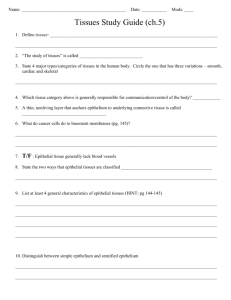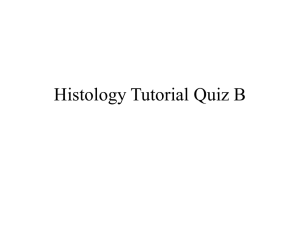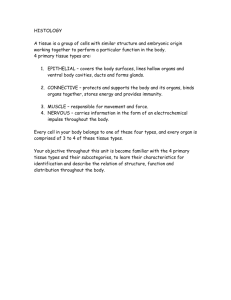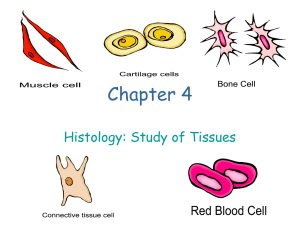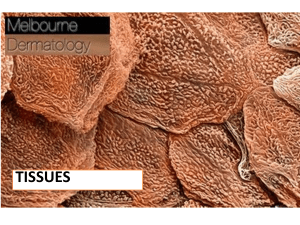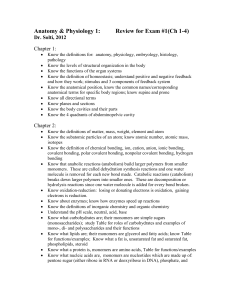More Tissues Notes for Your Resources
advertisement
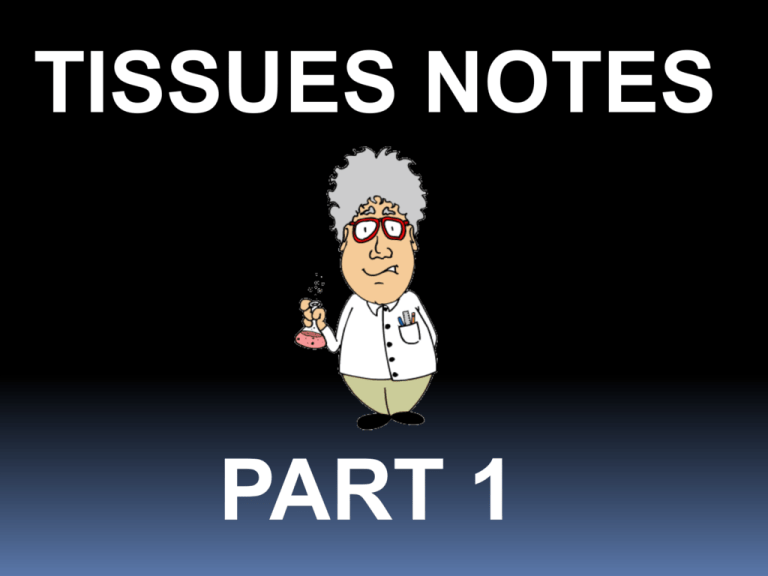
TISSUES NOTES PART 1 Learning Objectives Identify the four major tissue types and describe their functions. Describe the relationship between form and function for each tissue type. Describe the three types of muscle tissue and the structural features of each. Discuss the basic structure and role of neural tissue. NOTES - TISSUES • The human body is organized in the following manner: ATOMS MOLECULES CELLS TISSUES ORGANS ORGAN SYSTEMS ORGANISM (human) • TISSUE (definition) • 4 types of human tissue: • similar cells with the same function I. EPITHELIAL TISSUE II. CONNECTIVE TISSUE •Histology = study of tissues III. MUSCLE TISSUE IV. NERVOUS TISSUE Ed Copies Mrs. Notes Epithelial General Characteristics: -Main glandular tissue (glands) Cells reproduce rapidly Cells tightly packed together Attached to underlying connective tissue by noncellular nonliving basement membrane I. EPITHELIAL TISSUE • Function: • cover or lining of organs Function Continued 1. protection 2. Secretion 3.Absorption 4. Excretion 5. Sensory Perception http://www.bing.com/videos/search?q=epith elia+tissues&FORM=HDRSC3%20%20view=detail&mid=1B5CA938D182BBC2A 8A11B5CA938D182BBC2A8A1#view=detail& mid=782D40A6889DA04169A7782D40A6889 DA04169A7 Simple Squamous Location: heart and blood vessels, exchange surfaces of lungs Function: reduces friction, controls vessel permeability Simple Cuboidal Function: limited protection, performs absorption and secretion Location: glands, ducts, kidney tubules Simple Columnar Epithelium • long rectangles packed close together Function: • to secrete chemicals & absorb nutrients Location: • lining of digestive tract (stomach, intestines) Stratified Squamous Epithelium • Function: • protection from injury • cells on the bottom are round – they become flat near the top • Location: • skin 3. Ciliated Epithelium • (aka: psuedostratified) Function: Location: * there are other types of epithelium as well • • similar to columnar epithelium, but with CILIA movement of mucus or egg by action of cilia, nasal cavity, trachea and bronchi oviducts (fallopian tubes) Tracheal epithelium (ciliated) Transitional Epithelium Location: urinary bladder Function: permit expansion and recoil after stretching Figure 4.4 Epithelium Transitional Figure 4.4c TISSUES NOTES PART 2 Part 2: Connective Tissue General Characteristics: -Most abundant tissue in your body, found throughout -Binds structures together -Provides support, protection, framework, fills space, stores fat, produces blood cells, fights infection, and helps repair tissue. 4 common Types of Cells 1. mast cells (prevents blood clots) 2. macrophages (phagocytic ) Big Eater 3. fibroblasts (most abundant, produce fibers) 4. Fat Cells (adipose cells) Loose Connective Areolar: binds skin to underlying organs and organs to organs, space between muscles, throughout body Loose Connective ADIPOSE TISSUE - aka FAT, beneath skin, around kidneys and eyeballs, abdominal membranes. Function: Protective cushion, insulation to preserve body heat, stores energy, cells are called adipocytes Dense Connective Tissues dense tissue, closely packed, thick collagenous fibers and fine network of elastic fibers. Few cells, poor blood supply, thus slow healing. Example? Tendon = Ligament = Fluid Types 1. Blood 2.Lymph Blood Break Supporting 1. Bone 2. Cartilage Function of Bone and Cartilage Cartilage and bone support the rest of the body Cartilage Types: 1. Hyaline: most common 2. Elastic: external ear, epiglottis 3. Fibrocartilage: vertebrae of spinal column, pubic bones of pelvis Elastic Fibrocartilage Bone Difference Between Bone and Cartilage pg. 108 Osteoclasts: Tear Down Osteoblasts: Build UP B and B Osteoclasts/Osteoblasts https://www.youtube.com/watch?v=78RBpW SOl08 https://www.youtube.com/watch?v=78RBpW SOl08 Stand up! How to prevent osteoporosis? Muscle Tissue 1. Skeletal 2. Cardiac 3. Smooth https://www.youtube.com/watch?v=zirVm- mHQlQ https://www.youtube.com/watch?v=bwOE1M EginA 3 Types of Muscle Cells WS Nerual Tissue NEURAL TISSUE IS SPECIALIZED TO CONDUCT ELECTRICAL IMPULSES THAT CONVERY INFORMATION FROM ONE AREA OF THE BODY TO ANOTHER tps://www.youtube.com/watch?v=6qS83wD2 9PY Popcorn pg. 113 Neural Tissue Neurons - transmit signals Neuroglia - protection, support (supporting cells) STROOP ___________: Spinal Cord Importance of Cerebrospinal Fluid Circle and transmit signals 1. stand up 2. Sit down What messages were sent? Labeling a neuron Clay 3 Main Parts


